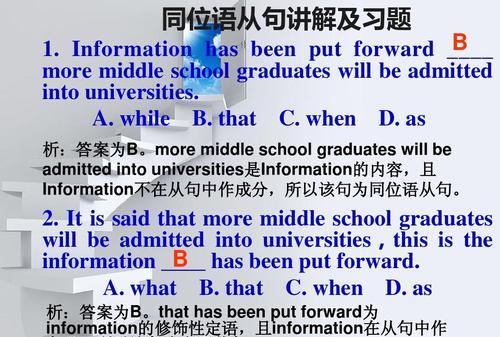同位语从句是英语语法中的一种结构,用于解释或补充名词或代词。判断同位语从句的方法包括寻找并分析同位语,注意从句的结构,以及理解同位语从句的作用。通过理解和应用同位语从句,可以更准确地理解和运用英语语法,提升语言表达能力。

1. 寻找并分析同位语
同位语从句是由同位语引导的一个完整的句子。因此,我们需要先找到同位语,然后分析它是否引导了一个从句。通常,同位语与前面的名词或代词之间会用逗号隔开,或者同位语之后出现一个“是(are)”或“包括(including)”等词。
例如:
- My favorite color, which is blue, is very relaxing.(同位语:My favorite color)
- The countries participating in the conference, including China and Russia, have agreed to sign the treaty.(同位语:The countries participating in the conference)
2. 注意从句的结构
同位语从句通常由连词“that”或“whether/if”引导。从句的结构与主从句相同,包括主语、谓语和宾语等成分。需要注意的是,同位语从句通常不能省略引导词。
例如:
- The fact that he passed the exam surprised us all.(同位语从句:that he passed the exam)
- I'm not sure whether/if I should attend the meeting.(同位语从句:whether/if I should attend the meeting)
3. 理解同位语从句的作用
同位语从句通常用来对前面的名词或代词进行解释或补充说明。因此,我们需要理解同位语从句的作用,以便更好地理解全文的含义。同位语从句可以起到修饰、解释、补充、举例、比较等作用。
例如:
- My favorite color, which is blue, is very relaxing.(同位语从句:which is blue,作用:修饰My favorite color)
- The countries participating in the conference, including China and Russia, have agreed to sign the treaty.(同位语从句:including China and Russia,作用:举例说明)

